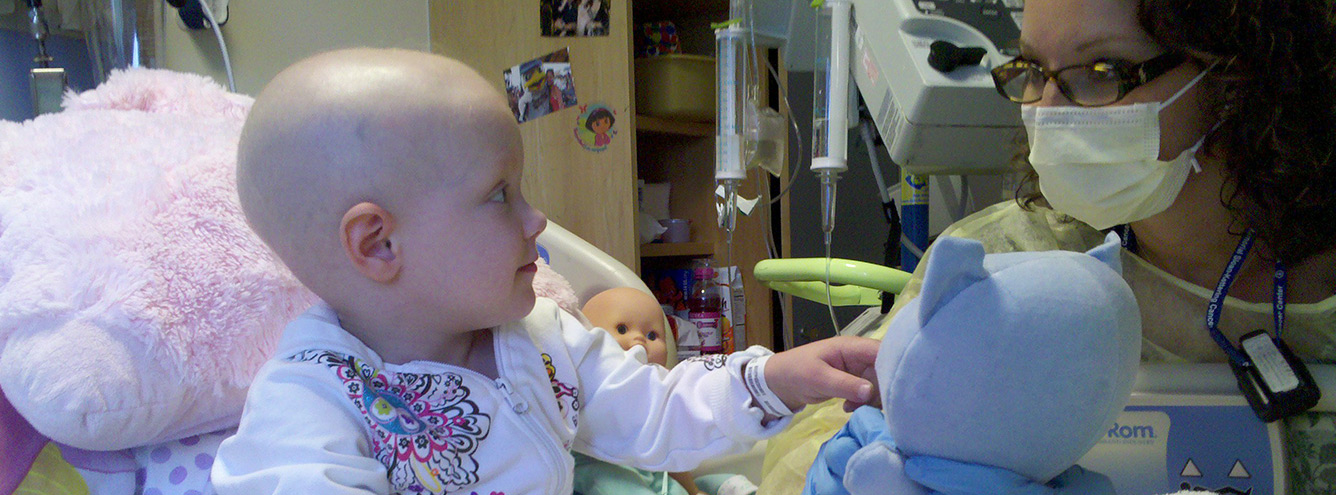When an eye is removed, a pathologist carefully examines it under a microscope for signs of cancer.
In particular, the pathologist and doctors treating your child’s retinoblastoma want to know if cancer has spread to:
- The optic nerve, and whether it is pre- or post-lamina (the Lamina Cribrosa is the point at which the nerve exits the eye).
- The anterior chamber (front of the eye), particularly the ciliary body, where fluid drains from the eye into the bloodstream.
- The choroid (second outermost layer of the eye).
- The sclera (outermost layer of the eye).
These high-risk pathological features indicate the child is at risk for cancer spread beyond the eye. Retinoblastoma most commonly spreads from the sclera and anterior chamber to bone marrow, bone and other organs, or via the optic nerve into the central nervous system (CNS), and cerebrospinal fluid (CSF).
The pathologist sends a report to your child’s ophthalmologist, detailing their findings. The ophthalmologist and oncologist will use the report to decide whether your child needs more treatment, and if so, which therapies are most appropriate.
The Results
You will be given an appointment to meet with the ophthalmologist a few weeks after your child’s surgery. At this appointment, the doctors will discuss the pathology results and whether any further treatment is required.
If the cancer has not spread, no further treatment is needed for that eye. The other eye may need ongoing treatment if it contains cancer. If pathology documents features that indicate high risk for cancer spread, further treatment and follow up care should be promptly and thoroughly discussed.
Pathology Staging
When an eye is removed for retinoblastoma, is it usually staged using the TNMH pathology staging system (pTNM), which documents tumour, node and metastatic spread of cancer.
Post-operative care should be thoroughly discussed and begin promptly for any child with the following high or very high risk pathology findings: Very high risk features require more intensive treatment and surveillance for potential metastasis.
High-risk pathological features:
pT2: Tumour with minimal optic nerve and (or) choroidal invasion
- pT2a: Tumour superficially invades optic nerve head but does not extend past lamina cribrosa, OR tumour exhibits focal choroidal invasion.
- pT2b: Tumour superficially invades optic nerve head but does not extend past lamina cribrosa AND exhibits focal choroidal invasion.
Very high-risk pathological features:
pT3: Tumour with significant optic nerve and (or) choroidal invasion
- pT3a: Tumour invades optic nerve past lamina cribrosa but not to surgical resection line, OR tumour exhibits massive choroidal invasion > 3 mm in any dimension.
- pT3b: Tumour invades optic nerve past lamina cribrosa but not to surgical resection line, AND exhibits massive choroidal invasion > 3 mm in any dimension.
pT4: Tumour invades optic nerve to resection line or exhibits extraocular extension elsewhere:
- pT4a: Tumour invades optic nerve to resection line, but no extraocular extension identified.
- pT4b: Tumour invades optic nerve to resection line AND extraocular extension identified.
Post Enucleation Therapy
Treatment is given after surgery for three reasons:
- the pathologist has seen signs that some cancer cells may have escaped the eye
- the pathologist has found evidence that cancer has spread outside the eye
- the doctors have diagnosed cancer outside the eye from tests such as MRI, lumbar puncture, bone marrow aspiration and physical examination.
High Risk Features
When chemotherapy is prescribed because there is a high risk of cancer spread, it is called adjuvant chemotherapy, and is given to prevent recurrence. Usually treatment consists of 4-6 cycles of chemotherapy.
When appropriate therapy is given, and your child receives all prescribed therapy with close follow up, the chance of cure is very high.
Extraocular Retinoblastoma
If cancer has already spread outside the eye, treatment will depend on where it has spread, and how far. Radiotherapy may be prescribed in addition to chemotherapy when cancer cells have spread to the orbit (tissues surrounding the eye), or along the optic nerve beyond the lamina cribrosa (the point at which the nerve leaves the eye).
If cancer has spread far along the optic nerve or into the brain, your child may be given chemotherapy directly into the cerebrospinal fluid (fluid bathing the brain and spine). This intrathecal chemotherapy is given by lumbar puncture or via an ommaya reservoir (a catheter inserted in a ventricle of the brain, attached to a reservoir implanted under the scalp).
Where if is available, most children with extraocular cancer also receive high dose chemotherapy with “stem cell rescue”. Stem cells are removed from the child’s peripheral blood and returned after super high dose chemotherapy. When cancer invades the bone marrow, stem cell transplant may not be possible.
Stem cell transplant is highly complex, expensive, and unavailable in most countries.
The chances of curing children with extensive metastatic cancer, even with sophisticated therapies, is very poor. This is why early removal of the eye is vital to save the child’s life.
Further Reading
From our blog, August 2017: The Anatomy of Retinoblastoma Pathology


